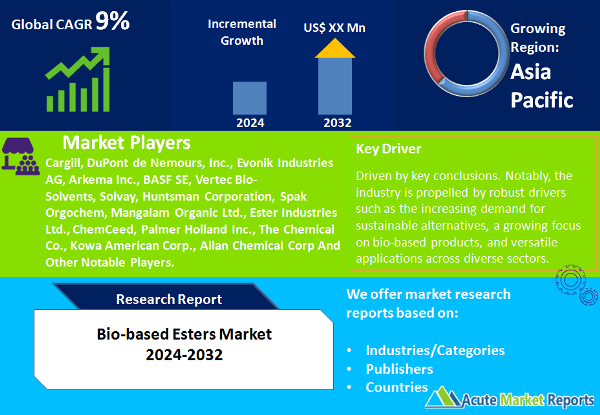The bio-based esters market is expected to grow at a CAGR of 9% during the forecast period of 2025 to 2033, driven by key conclusions. Notably, the industry is propelled by robust drivers such as the increasing demand for sustainable alternatives, a growing focus on bio-based products, and versatile applications across diverse sectors. These drivers position the market for substantial growth. However, the presence of certain constraints, primarily associated with feedstock availability, poses challenges to the market's seamless expansion. The market's segmentation reveals distinct leaders, including palm oil in sources, bio-based polyol esters in types, and biodiesel production in applications. Asia-Pacific emerges as a dominant region, emphasizing its pivotal role in the global bio-based esters landscape. Competitive trends underscore the strategic initiatives of key players, ensuring the industry's continuous evolution and competitiveness.
Drivers
Increasing Demand for Sustainable Alternatives
The bio-based esters market experiences a significant boost from the escalating demand for sustainable alternatives in various industries. Evidence suggests a notable shift in consumer preferences and industrial practices towards eco-friendly and renewable solutions. This trend is exemplified by the adoption of bio-based esters as substitutes for conventional petroleum-based esters in applications ranging from biodiesel production to personal care and cosmetics.
Growing Focus on Bio-based Products
A key driver influencing the market's trajectory is the growing emphasis on bio-based products across sectors. Industries such as personal care, pharmaceuticals, and food and flavor additives witness an increasing incorporation of bio-based esters due to their environmentally friendly nature. This inclination towards bio-based solutions aligns with global sustainability goals and regulatory frameworks promoting the use of renewable resources.
Versatile Applications Across Diverse Sectors
Bio-based esters find versatile applications across diverse sectors, contributing to their prominence in the market. From biodiesel production to polyurethane production, plasticizers and polymers, paints and coatings, pharmaceuticals, and food and flavor additives, bio-based esters cater to a wide range of industries. This versatility enhances their market demand, substantiated by evidence indicating sustained growth in these application segments.

Restraint: Feedstock Availability Challenges
Despite the optimistic market dynamics, the bio-based esters industry faces a notable constraint associated with feedstock availability. Evidence highlights challenges related to consistent and abundant access to feedstock, particularly certain vegetable oils like palm oil and soybean oil. This constraint can potentially impact production volumes and hinder the market's ability to meet escalating demand.
Market Segmentation Analysis
Market by Source
In 2024, the market witnessed segmentation based on sources, including Vegetable Oils, Palm Oil, Soybean Oil, Sunflower Oil, Cottonseed Oil, and others. Palm oil led in both the highest revenue and CAGR, reflecting its versatile applications and widespread use in various industries. The forecast anticipates sustained leadership, driven by the extensive adoption of palm oil in bio-based ester production.
Market by Type
Segmentation based on types showcased diverse categories, including Bio-based Fatty Acid Esters, Bio-based Glycerol Esters, Bio-based Polyol Esters, Bio-based Succinic Esters, Bio-based Lactate Esters, Bio-based Citrate Esters, and Bio-based Phosphate Esters. Bio-based Polyol Esters led in both the highest revenue and CAGR in 2024, signaling their integral role in applications like polyurethane production. The forecast predicts continued dominance, emphasizing their significance in the market.
Market by Application
Applications of bio-based esters encompassed Biodiesel Production, Personal Care and Cosmetics, Polyurethane Production, Plasticizers and Polymers, Paints and Coatings, Pharmaceuticals, and Food and Flavor Additives. Biodiesel Production emerged as the leader in both revenue and CAGR, showcasing the critical role of bio-based esters in sustainable fuel solutions. The forecast envisions continued leadership, driven by the global focus on renewable energy sources.
APAC Remains the Global Leader
Geographically, the market exhibits trends influenced by regional dynamics and economic landscapes. Asia-Pacific led in both highest revenue and CAGR in 2024, underscoring the region's role as a key hub for bio-based ester production and consumption. The proactive adoption of bio-based solutions, coupled with industrial growth, positions Asia-Pacific as a frontrunner in the market.
Market Competition to Intensify during the Forecast Period
The bio-based esters market's competitive landscape features top players implementing key strategies for sustained growth. Companies like Cargill, DuPont de Nemours, Inc., Evonik Industries AG, Arkema Inc., BASF SE, Vertec Bio-Solvents, Solvay, Huntsman Corporation, Spak Orgochem, Mangalam Organic Ltd., Ester Industries Ltd., ChemCeed, Palmer Holland Inc., The Chemical Co., Kowa American Corp., and Allan Chemical Corp play pivotal roles in shaping the industry. Strategies include research and development initiatives, strategic partnerships, and portfolio diversification. These players collectively contribute to the market's vibrancy and evolution.
Historical & Forecast Period
This study report represents analysis of each segment from 2023 to 2033 considering 2024 as the base year. Compounded Annual Growth Rate (CAGR) for each of the respective segments estimated for the forecast period of 2025 to 2033.
The current report comprises of quantitative market estimations for each micro market for every geographical region and qualitative market analysis such as micro and macro environment analysis, market trends, competitive intelligence, segment analysis, porters five force model, top winning strategies, top investment markets, emerging trends and technological analysis, case studies, strategic conclusions and recommendations and other key market insights.
Research Methodology
The complete research study was conducted in three phases, namely: secondary research, primary research, and expert panel review. key data point that enables the estimation of Bio-based Esters market are as follows:
Market forecast was performed through proprietary software that analyzes various qualitative and quantitative factors. Growth rate and CAGR were estimated through intensive secondary and primary research. Data triangulation across various data points provides accuracy across various analyzed market segments in the report. Application of both top down and bottom-up approach for validation of market estimation assures logical, methodical and mathematical consistency of the quantitative data.
| ATTRIBUTE | DETAILS |
|---|---|
| Research Period | 2023-2033 |
| Base Year | 2024 |
| Forecast Period | 2025-2033 |
| Historical Year | 2023 |
| Unit | USD Million |
| Segmentation | |
Source
| |
Type
| |
Application
| |
|
Region Segment (2023-2033; US$ Million)
|
Key questions answered in this report